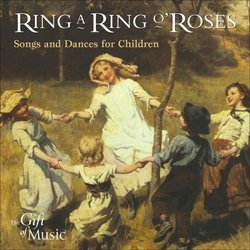| All Artists: Musica Donum Dei Title: Ring a Ring o Roses Members Wishing: 2 Total Copies: 0 Label: The Gift of Music Original Release Date: 1/1/2003 Re-Release Date: 3/4/2005 Genres: Folk, Special Interest, Classical, Children's Music Styles: Marches, Opera & Classical Vocal, Chamber Music, Historical Periods, Baroque (c.1600-1750), Instruments, Keyboard, Symphonies Number of Discs: 1 SwapaCD Credits: 1 UPC: 658592051025 |
Search - Musica Donum Dei :: Ring a Ring o Roses
 | Musica Donum Dei Ring a Ring o Roses Genres: Folk, Special Interest, Classical, Children's Music
This album brings together many old tunes which are familiar to us through nursery rhymes or folk tunes which we learnt as a child - and have so often half-forgotten! However, it is a telling tribute to the durabilitiy of ... more » |
Larger Image |
CD Details
Synopsis
Product Description
This album brings together many old tunes which are familiar to us through nursery rhymes or folk tunes which we learnt as a child - and have so often half-forgotten! However, it is a telling tribute to the durabilitiy of these tunes and themes that even in this age of technical sophistication, of computer games and multi-media presentations, many children will still know them from the school playground or from television programmes or school lessons. So the album becomes an'aide-memoire' for parents and grandparents, and can be used as a useful little teaching aid to ensure that these tunes remain in children's minds. From the Artist Musica Donum Dei, Wendy Hancock flute and recorders, Michael Sanderson voice and fiddle, Michael Overbury harpsichord, Julia Black fiddle, Dianne Terry fiddle and viola, Imogen Seth-Smith cello, Susanne Heinrich gamba. Here is a list of the composers and when they lived: John Playford (1623-1686) Jeremiah Clarke (1674-1707) Henry Purcell (1659-1595) George Frideric Handel (1685-1759) Francois Couperin (1668-1733) One of the reasons the tunes have lasted so long, is that they are simply very good. Even something as simple as 'This old man' is very attractive to listen to, and it is highly memorable, especially in this lovely new arrangement which was created especially for the album. Most of the familiar tunes have been treated in a similar manner, and a fresh, new sound had been created, even though they are all played on old instruments, or copies of them. The violins, violas and cellos are set up and played in the styles of the seventeenth and eighteenth centuries, with gut strings in place of the more usual metal, and different shaped bows under much less pressure. The sound they make becomes very open and clear. The flute is also in the Baroque style. It is made of wood and has holes for the player to cover with the fingers instead of the key system of the modern, metal flute. Although it is played 'transversely' (i.e. held horizontally) its sound is thus closer in many ways to its cousin, the recorder, which is familiar to nearly every school child and is, of course, played in a vertical position. These lovely and varied instruments are accompanied by the harpsichord. This instrument has a keyboard like a modern piano, but whereas the piano has a mechanism inside which causes a hammer to strike its strings, the harpsichord mechanism is one which plucks the strings, and it thus produces a totally different sound from the piano. The harpsichord is one of the oldest instruments, and was in regular use until the piano became firmly established in the last two or three decades of the eighteenth century. Many of the pieces on the album are by important composers of the seventeenth and eighteenth centuries. George Frideric Handel is probably the most famous of them all. He wrote his 'Water Music' for King George II in 1717. Francois Couperin was his near contemporary who worked for the Sun King, Louis XIV of France. Many of his pieces have clever titles, and imitate things in the world around the composer, such as this 'alarm clock' piece. Henry Purcell worked in London towards the end of the seventeenth century. He was an organist at Westminster Abbey, and wrote large amounts of music for the theatre. Jeremiah Clarke was less well-known, but his trumpet tunes (such as the 'Prince of Denmark's March' or the middle tune of the three pieces from 'The Island Princess') have always remained familiar. John Playford was a musician and music publisher. He printed huge amounts of music based on, amongst other things, the favourite dance tunes of the day.

 Track Listings (28) - Disc #1
Track Listings (28) - Disc #1